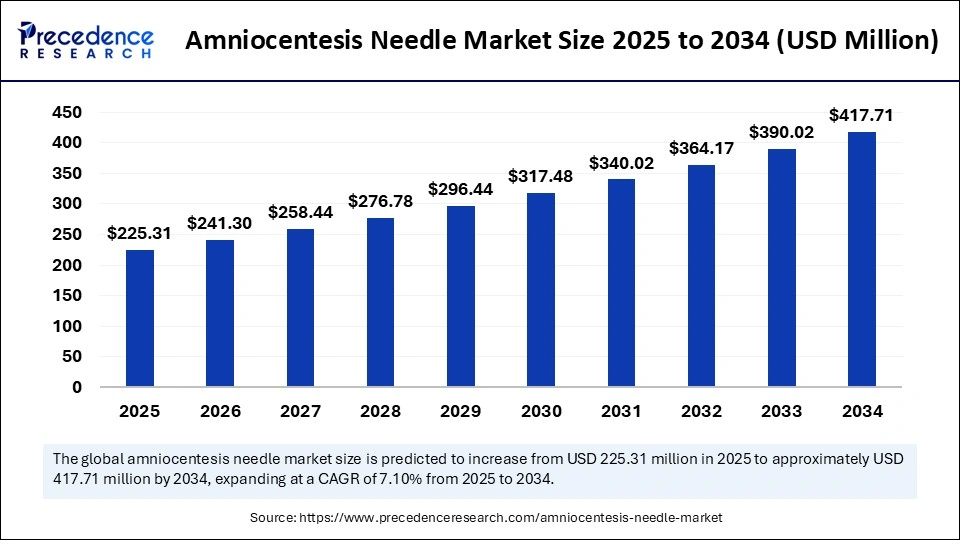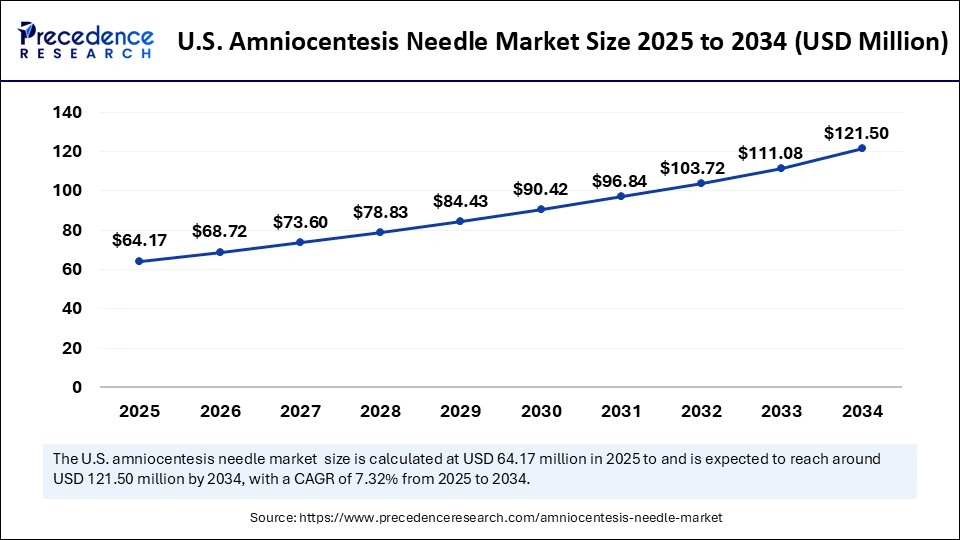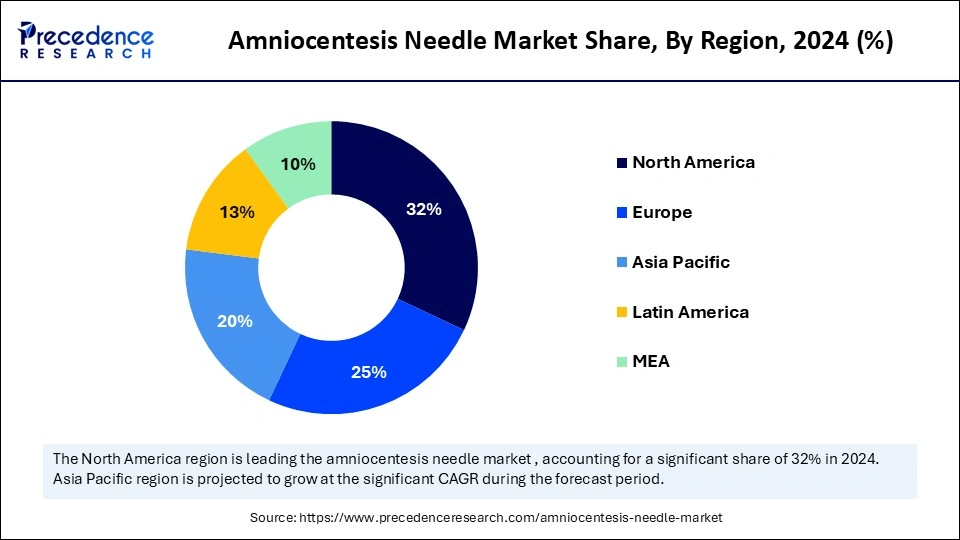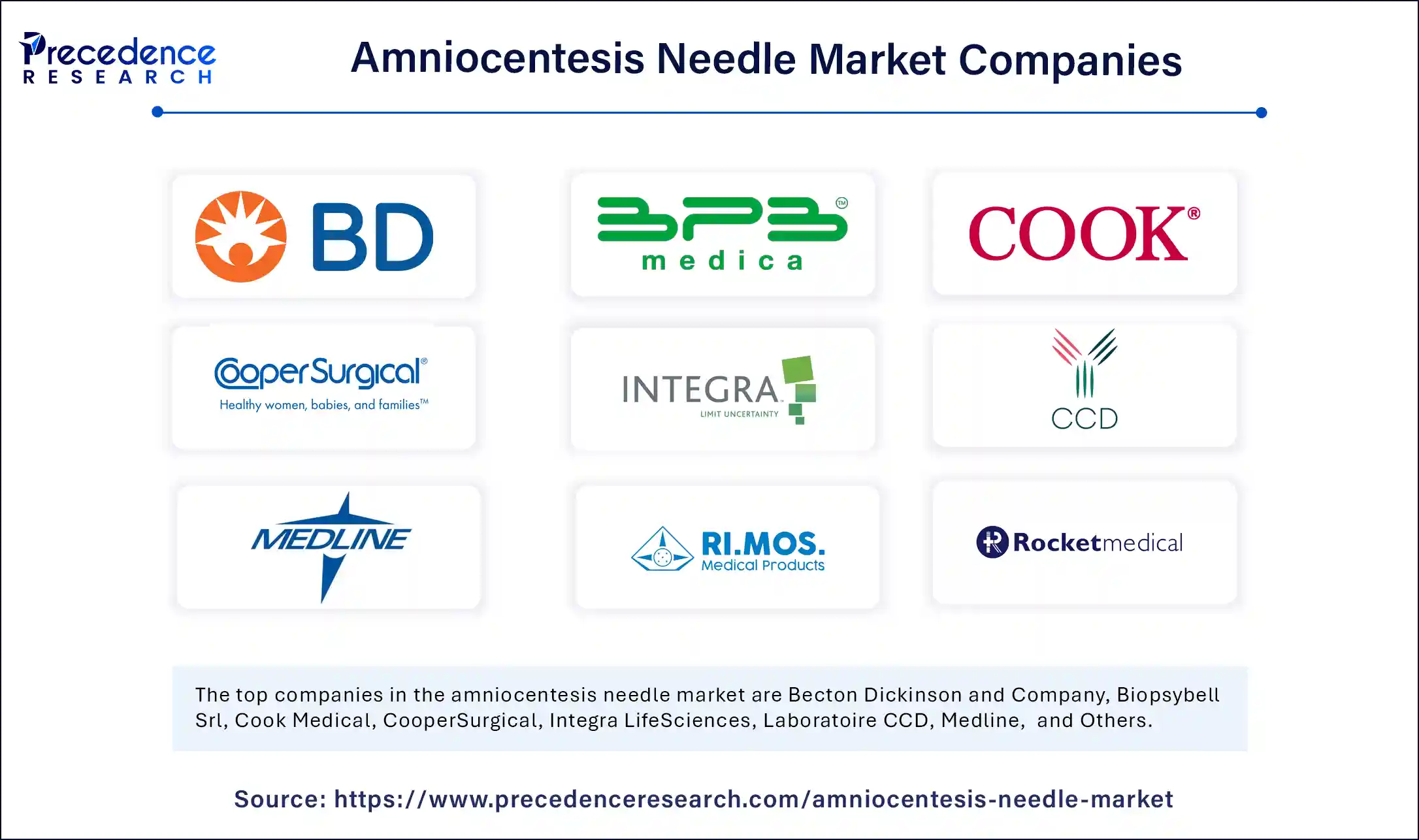List of Contents
Amniocentesis Needle Market Size and Forecast 2025 to 2034
The global amniocentesis needle market size accounted for USD 210.37 million in 2024 and is predicted to increase from USD 225.31 million in 2025 to approximately USD 417.71 million by 2034, expanding at a CAGR of 7.10% from 2025 to 2034. The market growth is attributed to the increasing prevalence of high-risk pregnancies and advancements in prenatal genetic testing technologies.

Amniocentesis Needle Market Key Takeaways
- In terms of revenue, the market is valued at $225.31 million in 2025.
- It is projected to reach $417.71 million by 2034.
- The market is expected to grow at a CAGR of 7.10% from 2025 to 2034.
- North America held the major market share of 32% in 2024.
- Asia Pacific is expected to grow at a CAGR of 7.1% in the upcoming period (2025-2034).
- By type, the 100 to 150 mm segment contributed the biggest market share of 53% in 2024.
- By type, the smaller than 100 mm segment is expected to grow at the fastest rate between 2025 and 2034.
- By procedure, the amniocentesis procedures segment led the market in 2024.
- By procedure, the fetal blood transfusion segment is projected to grow at a significant CAGR during the assessment years.
- By end-use, the hospitals segment accounted for the biggest market share of 35% in 2024.
- By end-use, the clinics segment is projected to expand rapidly in the market in the coming years.
Impact of Artificial Intelligence on the Amniocentesis Needle Market
Artificial intelligence increases the accuracy and safety of amniocentesis needle procedures. By utilizing AI-powered ultrasound, clinicians can see live needle placement, limiting the possibility of adverse outcomes in fetal sampling. Manufacturers can use AI technologies to design models that show needles' interactions with different anatomies. AI also helps in the development of next-generation needles. Furthermore, AI enhances the quality of amniocentesis needles.
U.S. Amniocentesis Needle Market Size and Growth 2025 to 2034
The U.S. amniocentesis needle market size was exhibited at USD 59.91 million in 2024 and is projected to be worth around USD 121.50 million by 2034, growing at a CAGR of 7.32% from 2025 to 2034.

North America led the amniocentesis needle market by capturing the largest share in 2024. This is mainly due to its advanced healthcare system and increased awareness among people about the importance of prenatal genetic screening. The U.S. held the maximum share with its increased investment in comprehensive diagnostic tools and the high incidence of high-risk pregnancies. Supportive regulatory frameworks for prenatal care and increased need for genetic testing boosted the demand for amniocentesis procedures. The CDC predicted that prenatal genetic screening (amniocentesis) will remain at the forefront of attention in 2024 as a result of expectant mothers' heightened awareness and advanced prenatal technologies. The increase in the number of high-risk pregnancies and the usage of non-invasive prenatal testing bolstered the growth of the market.

Asia Pacific is anticipated to witness the fastest growth during the forecast period. The rising government initiatives to improve healthcare infrastructure, particularly in countries like China and India, are likely to boost the growth of the market. There is a strong emphasis on maternal care, boosting the demand for various diagnostic procedures, including amniocentesis. The rise in older maternal age and high-risk pregnancies is contributing to the demand for genetic screening tests. India plays a major role in the Asia Pacific amniocentesis needle market. The increasing number of cases of genetic diseases and the availability of advanced prenatal screening options are driving the growth of the market.
Europe is expected to witness notable growth, driven by increasing investment in healthcare and high demand for sophisticated prenatal testing. European countries such as Germany, France, and the UK have robust healthcare infrastructure, with the widespread availability of sophisticated diagnostic solutions. Additionally, the increasing number of cases of complicated pregnancies, especially among older women, is projected to raise the demand for amniocentesis in this region.
Market Overview
The worldwide amniocentesis needle market is witnessing significant growth due to the rising demand for reliable prenatal genetic testing. The rising number of cases of high-risk pregnancies, notably among women who are 35 and older, creates the need for early and accurate detection of chromosomal aberrations. This significantly boosts the demand for advanced prenatal screening options, in which amniocentesis needles play a crucial role. According to the MAYO CLINIC's report, around 100,000 women in the U.S. gave birth at the age of 40 in 2023. This further intensifies the need for amniocentesis to support reliable diagnoses.
Amniocentesis Needle Market Growth Factors
- Rising Adoption of Non-Invasive Prenatal Testing: The growing popularity of non-invasive prenatal tests (NIPT), which support early detection of genetic disorders, significantly increases the need for amniocentesis procedures.
- Advancements in Ultrasound Technology: Continuous improvements in ultrasound systems are anticipated to enhance the safety and accuracy of amniocentesis procedures, driving demand for precision needles.
- Increasing Healthcare Access in Developing Regions: Expanding healthcare infrastructure in emerging markets like India and China is likely to increase access to prenatal diagnostic services, including amniocentesis.
- Government Support for Prenatal Care: Policies aimed at improving maternal health, such as subsidized prenatal testing and genetic counseling programs, are projected to boost the adoption of amniocentesis procedures globally.
- Rising Maternal Age: The increasing trend of delayed pregnancies, especially among women over 35, is expected to drive demand for prenatal diagnostic tests like amniocentesis, as older mothers are at higher risk for genetic disorders.
- Enhancements in Needle Technology: Innovations such as improved needle coatings and ergonomic designs are expected to make amniocentesis procedures safer, leading to wider acceptance and growth in usage.
- Growing Focus on Personalized Medicine: The shift towards personalized healthcare, with an emphasis on genetic testing and tailored treatments, is likely to further drive the demand for amniocentesis as a diagnostic tool for genetic disorders.
Market Scope
| Report Coverage | Details |
| Market Size by 2034 | USD 417.71 Million |
| Market Size in 2025 | USD 225.31 Million |
| Market Size in 2024 | USD 210.37 Million |
| Market Growth Rate from 2025 to 2034 | CAGR of 7.10% |
| Dominating Region | North America |
| Fastest Growing Region | Asia Pacific |
| Base Year | 2024 |
| Forecast Period | 2025 to 2034 |
| Segments Covered | Type, Procedure, End-use, and Region |
| Regions Covered | North America, Europe, Asia-Pacific, Latin America, and Middle East & Africa |
Market Dynamics
Drivers
Rising Prevalence of Genetic Disorders
The increasing rates of genetic disorders are anticipated to boost the need for diagnostic procedures like amniocentesis, which drives the growth of the amniocentesis needle market. The healthcare sector is experiencing rapid surge in the number of cases of chromosomal abnormalities, such as Down syndrome, Edwards syndrome and neural tube defects. Medical specialists commonly recommend amniocentesis as a reliable procedure for diagnosis of these conditions in the second trimester. Early and accurate fetal examinations are becoming increasingly important. According to the U.S. Centers for Disease Control and Prevention's 2024 report, about one of 700 babies born in the U.S. develops a risk of Down Syndrome. This number is expected to rise in the coming years due to factors like hormonal changes, creating the need for amniocentesis procedures.
Restraint
Rising Preference for Non-Invasive Prenatal Testing
The rising preference for non-invasive prenatal testing (NIPT) is expected to hinder the growth of the amniocentesis needle market. Medical centers are beginning to prefer non-invasive prenatal testing (NIPT), which involves examination of the mother's blood for evidence of chromosomal abnormality. NIPT reduces the risks associated with amniocentesis. Healthcare professionals and consumers are becoming more aware of the benefits and availability of non-invasive procedures, encouraging them to shift toward NIPT. This significantly reduces the need for amniocentesis needles.
Opportunity
Increasing Global Healthcare Expenditure
Increasing global healthcare expenditure is projected to create immense opportunities for players competing in the amniocentesis needle market. Higher healthcare spending enables wider access to prenatal care, including amniocentesis procedures. Higher spending further contributes to research and development, leading to innovations in amniocentesis needles. The rising government initiatives to improve maternal care opens up new avenues for market growth by increasing the availability of prenatal tests.
- According to the World Health Organization (WHO), the total expenditure on healthcare globally was USD 8.3 trillion by 2024, of which a massive budget was spent on maternal and child health services.
Type Insights
The 100 to 150 mm segment held the biggest market share of 53% in 2024. This is mainly due to their best balance between precision and user-friendliness. This is the optimal range for drawing amniotic fluid during the second-trimester amniocentesis, a procedure normally performed between 15 and 20 weeks of pregnancy. These needles ensure safe and effective insertion into the amniotic sac, minimizing the risk of injury to both fetus and mother. Moreover, these mid-length needles are applicable for vaccination and drug administration due to their versatility.
The smaller than 100 mm segment is expected to grow at the fastest rate in the upcoming period. The growth of the segment is attributed to the increasing demand for minimally invasive techniques. These needles reduce injury risks to the fetus due to their smaller size and less invasive nature. This further enhances the comfort of the patient. Furthermore, the increasing maternal and fetal safety concerns drive the growth of this segment.
Procedure Insights
The amniocentesis procedures segment accounted for the major market share in 2024. This is mainly due to their major role in detecting genetic disorders during the second stage of gestation. Clinicians take advantage of these procedures for the purpose of taking samples of amniotic fluid. Further, they are tested to identify chromosomal disorders, such as Down syndrome and Edwards syndrome. As per the report published by the United Nations, 1 in 1000 children are born with Down syndrome each year. Moreover, approximately 3,000 to 5,000 children are born with a chromosome disorder. Furthermore, age-related pregnancies are associated with an elevated rate of genetic disorders, leading to an increased use of amniocentesis.
The fetal blood transfusion segment is projected to grow at a significant CAGR during the assessment years. A fetal blood transfusion is normally done when the fetus is at risk of blood anemia, and care must be taken to ensure that there are no complications. Increasing rates of Rh incompatibility and other blood incompatibilities in pregnancy are expected to increase the demand for FBT. The World Health Organization (WHO) has recognized that fetal anemia is one of the most important factors increasing fetal morbidity and mortality in certain regions. Additionally, improvements in accessibility to healthcare services in developing regions are projected to drive the growth of the segment.
End-use Insights
The hospitals segment generated the biggest market share of 35% in 2024. Amniocentesis demand in hospitals is tremendous since these centers have adequate facilities to treat high-risk pregnancies, genetic disorders, and multiple complications. These settings come with modern ultrasound-guided equipment, which makes the amniocentesis procedures more accurate. The increased rates of high-risk pregnancies and the increased relevance of genetic testing imply that hospitals remain the primary providers of prenatal diagnosis.

The clinics segment is projected to expand rapidly in the market in the coming years, due to the convenience of access, quick service, and more affordable prices as compared to the hospital environment. More women are opting to undertake early prenatal screening and genetic screening privately in less congested environments. Clinics where specialized care and personalized service are preferred are likely to experience an increase in the number of these procedures undertaken amniocentesis procedures. Furthermore, improvements in diagnostic technology, rising popularity of elective prenatal testing, and frequency of amniocentesis procedures at clinics are expected to increase.
Amniocentesis Needle Market Companies

- Becton Dickinson and Company
- Biopsybell Srl
- Cook Medical
- CooperSurgical
- Integra LifeSciences
- Laboratoire CCD
- Medline
- RI.MOS. Srl
- Rocket Medical
- Smith's Medical
Recent Developments
- In March 2025, Israeli researchers are testing a fetal screening method that may replace traditional amniocentesis. Led by Prof. Noam Shomron at Tel Aviv University, the new technique involves a routine blood sample from the mother rather than extracting amniotic fluid with a needle, which carries a miscarriage risk. This blood-based test can be conducted as early as 10 weeks into pregnancy—four weeks earlier than standard amniocentesis—and provides comparable genetic information on syndromes, diseases, and disorders. The innovation could mark a safer and earlier step forward in prenatal care.
- In September 2023, a new amniocentesis needle was introduced by Medtronic. This next-generation needle exhibits enhanced safety features, including a thinner gauge and improved echogenicity for better ultrasound visibility. This needle is designed to reduce patient discomfort and procedural risks.
Segments Covered in the Report
By Type
- 100 to 150 mm
- Larger Than 150 mm
- Smaller Than 100 mm
By Procedure
- Amniocentesis Procedures
- Amnioinfusion Procedures
- Amnioreduction Procedures
- Cordocentesis Procedures
- Fetal Blood Transfusion
By End-use
- Clinics
- Diagnostics Centers
- Hospitals
- Others
By Region
- North America
- Europe
- Asia Pacific
- Latin America
- Middle East and Africa
For inquiries regarding discounts, bulk purchases, or customization requests, please contact us at sales@precedenceresearch.com
Frequently Asked Questions
Ask For Sample
No cookie-cutter, only authentic analysis – take the 1st step to become a Precedence Research client